Fallout from the bomb cyclone emphasized the importance of winter weather on the natural gas market and seasonal basis, as Henry Hub climbed over $6/MMBtu and Transco Z6 NY reached $175/MMBtu. As the East Coast thaws, we at BTU Analytics are focused on what lies ahead for the natural gas market. How weather for the rest of the winter plays out will set the stage for the market in 2018, though we are also keeping a close eye on infrastructure constraints between regions with growing supply and growing demand, as this will also have important basis implications. A tangible example is in Appalachia, specifically Northeast PA, which may be a useful analogy for other regions in the US over the next few years.
Natural gas production in Northeast PA has been relatively sensitive to gas prices: production has decreased in summer and shoulder season with weak pricing, and increased in winter as demand and prices pick back up, as seen in the figure below. For the past two years, October production has fallen nearly 1 Bcf/d from previous winter highs, and TGP Zone 4 pricing has averaged under $1/MMBtu. This gives an indication of shut-in pricing for the region, as prices falling further below $2.00 results in incrementally more precipitous curtailments in production.

Location of pipeline takeaway capacity is influencing these seasonal drops. A key market for Northeast PA production is New England but pipeline capacity from Northeast PA to New England is constrained in the winter (and given the difficulty in building a new pipeline in New York, this does not look to be alleviated any time soon). However, in the summer, Northeast PA can serve all New England’s demand; i.e., the region is demand constrained in the summer. This is illustrated in the figure below, with flows to New England from Appalachia limited by pipe capacity in winter months, and New England demand in summer months.

Another important outlet for Northeast PA production is the Atlantic Seaboard, though flows to the Atlantic Seaboard are limited by pipeline takeaway capacity throughout the year, as illustrated in the figure below. With new pipe capacity, additional Appalachian production could go to serve demand in the Atlantic Seaboard in the summer and shoulder seasons. The outlook for Northeast PA will be improved this year as the greenfield portion of Atlantic Sunrise is set to become operational mid-2018. However, the key for basis in 2018 will be the timing of when the pipeline is in service and how quickly it fills with new production. Ultimately, production from Northeast PA in summer and shoulder seasons has been demand constrained where there is pipe capacity (e.g., Northeast PA to New England), pipe constrained where there is demand and opportunity to capture more market share (e.g., Northeast PA to Atlantic Seaboard), resulting in downward pressure and shut-in pricing.

Taking a step back, these dynamics may be at play for a larger part of the US, as there is a disconnect between regions with growing natural gas supply (Appalachia, Permian, DJ) and regions with growing demand (Gulf Coast), as illustrated in the figure below. Similar to Northeast PA, these supply regions as a whole are setting up to be demand constrained where there is pipe capacity (Midwest), and pipe constrained where demand is growing (Gulf Coast). These growing supply regions are contained by what we are dubbing the ‘arc of pain’ (a boundary that runs from Texas to the Mid-Atlantic as shown by the red line below), which sets up competition for pipe capacity to reach growing demand along the Gulf Coast. These dynamics will set up a sustained period of weak supply area basis north of the ‘arc of pain’ due to constraints, particularly in the summer and shoulder seasons. Complicating the picture, however, is the fact there are competing basins with different sensitivities to gas prices: i.e., oil plays with associated gas like the Permian and DJ.

Are we set up for pain and shut-in pricing in the summer shoulder seasons in regions above the arc where there is growing supply but finite demand? Conversely, is there enough supply to make it across the arc to meet growing demand along the Gulf Coast, and what are the price implications for Henry Hub? We will be addressing these questions at our What Lies Ahead conference in February and check out our suite of products that cover our view on the changing dynamics of the natural gas market, including the Henry Hub Outlook, Northeast Gas Outlook, and Upstream Outlook.









